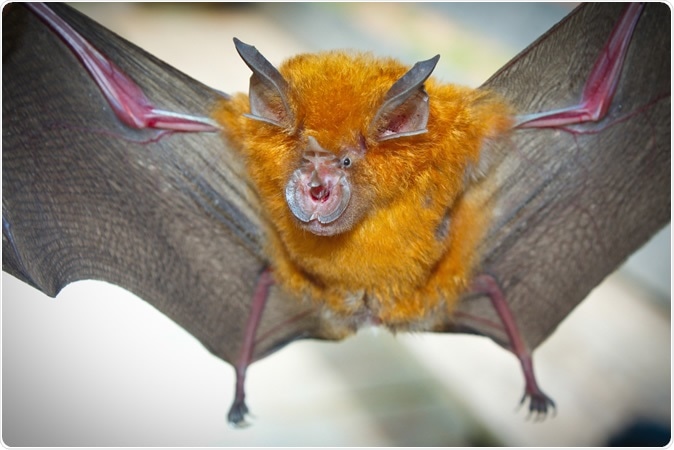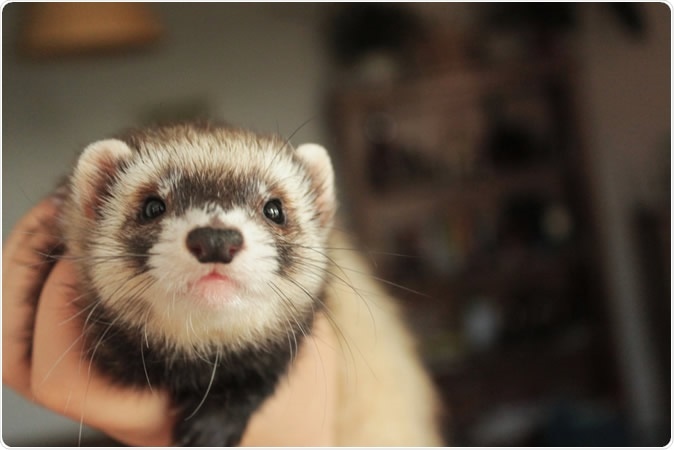A recent paper by Chinese researchers, published in the leading journal Science, shows that severe acute respiratory syndrome coronavirus 2 (SARS-CoV-2) does not replicate well in dogs, pigs, chickens, and ducks; however, ferrets and cats are easily infected, and cats may transmit the virus via an airborne route.
Despite global efforts to curb the ongoing coronavirus disease (COVID-19), this serious respiratory disease caused by SARS-CoV-2 continues to spread. Although the virus is believed to be zoonotic – as it shares at least 96% of its genetic identity with a coronavirus detected in horseshoe bats - the exact origin is still a matter of intense debate.

Horseshoe Bat (Rhinolophus affinis). Image Credit: Binturong-tonoscarpe / Shutterstock
Moreover, there are still some lingering questions that necessitate clear-cut scientific answers. Can the virus spread to other animal species that may subsequently serve as disease reservoirs? How does the virus behave in different animals? And which animals are best suited to serve as potential models in our quest to develop an efficient vaccine?
Domestic animals and COVID-19
Cats and dogs are in close contact with humans; therefore, it is important to get a full grasp of their role in this pandemic. A recent study from Japan showed how almost all cases of COVID-19 among domestic animals could be linked to their owners infected with SARS-CoV-2.
Moreover, a study came out from Hong Kong indicating that two of nineteen dogs and one of nine cats from households with confirmed human COVID-19 cases (or individuals in close contact with confirmed patients) tested positive for SARS-CoV-2. Some researchers even suggested that stray dogs may have acted as the origin of the current pandemic.
To address the aforementioned research questions, scientists from the Chinese Academy of Agricultural Sciences, Chinese National Institute for Viral Disease Control and Prevention, as well as the Chinese National High Containment Laboratory for Animal Diseases Control and Prevention, decided to appraise the susceptibility of different laboratory and domestic animals to SARS-CoV-2.
Ferret versus domesticated animals
To investigate the replication dynamics of SARS-CoV-2 viral strains in ferrets, the animals were first inoculated intranasally, and each ferret was then put in a different cage within an isolator. Nasal washes and rectal swabs were then collected every two days for virus titration and viral RNA detection.
"The nasal turbinate, soft palate, tonsils, trachea, lung, heart, liver, spleen, kidneys, pancreas, small intestine, and brain from each ferret were collected for viral RNA quantification by quantitative polymerase chain reaction and virus titration in Vero E6 cells", study authors explain their exhaustive research approach.
But ferrets are considered prototypical laboratory animals; hence, a similar approach has been taken for juvenile and sub-adult cats, dogs, pigs, chickens, and ducks to obtain a full picture. Additional replication and transmission studies, as well as virus attachment and histopathological studies, were conducted.

Domestic ferret. Image Credit: Bea K / Shutterstock
All experiments with SARS-CoV-2 were performed in the biosafety level 4 and animal biosafety level 4 facilities (which is the highest safety level) in the Harbin Veterinary Research Institute of the Chinese Academy of Agricultural Sciences.
The inclusion of cats into SARS-CoV-2 surveillance
The researchers found that ferrets and cats can be singled out as highly susceptible to SARS-CoV-2. Conversely, dogs exhibit low susceptibility, while pigs, chickens, and ducks are not susceptible to the virus at all. Moreover, there are some stark differences between susceptible animals as well.
In contrast to influenza viruses and other SARS-coronavirus which replicate in both the upper and lower respiratory tract in ferrets, SARS-CoV-2 replicates only in the nasal turbinate, tonsils and soft palate of ferrets. The virus was also shown to possibly replicate in their digestive tract since viral RNA was detected in the rectal swabs.
However, the virus was not detected in the lung lobes of ferrets – even after they were inoculated intratracheally – which means the virus is not replicating in the lower respiratory tract. Why that is the case with SARS-CoV-2 remains a research question of interest.
"The fact that SARS-CoV-2 replicates efficiently in the upper respiratory tract of ferrets makes them a candidate animal model for evaluating the efficacy of antiviral drugs or vaccines against COVID-19", highlight study authors in their Science paper.
Other notable study finding was that virus can spread airborne between cats. Since this means infected felids managed to transmit the virus to non-infected ones, SARS-CoV-2 surveillance in cats should be considered as an adjunct approach to our ambitious goal of eliminating COVID-19 in humans.